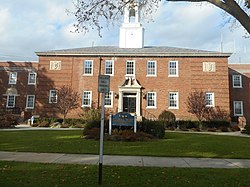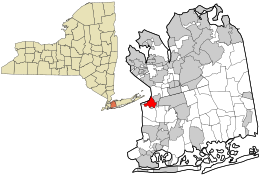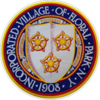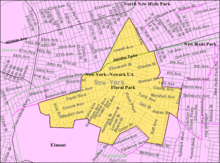
Nassau County is a suburban county located on Long Island, immediately to the east of New York City. As of the 2020 United States census, Nassau County's population was 1,395,774 with one police department, making it the sixth-most populous county in the State of New York, and reflecting an increase of 56,242 (+4.2%) from the 1,339,532 residents enumerated at the 2010 census. Its county seat is Mineola, while the county's largest town is Hempstead.

Mineola is a village in and the county seat of Nassau County, on Long Island, in New York, United States. The population was 20,800 at the 2020 census. The name is derived from an Algonquin Chief, Miniolagamika, which means "pleasant village".

Bellerose is a village in the Town of Hempstead in Nassau County, on Long Island, in New York, United States. The population was 1,173 at the 2020 census.
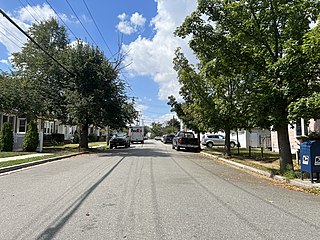
Bellerose Terrace is a hamlet and census-designated place (CDP) in the Town of Hempstead in Nassau County, on Long Island, in New York, United States. The population was 2,329 at the 2020 census.

Elmont is an unincorporated hamlet and census-designated place (CDP) located in northwestern Hempstead in Nassau County, New York, United States, along its border with the borough of Queens in New York City. The population was 35,265 at the 2020 census.

Franklin Square is a hamlet and census-designated place (CDP) in the Town of Hempstead in Nassau County, on Long Island, New York, United States. The population was 30,903 at the time of the 2020 census.

Inwood is a hamlet and census-designated place (CDP) in Nassau County, on Long Island, in New York, United States. The population was 11,340 at the time of the 2020 census. It is considered part of Long Island's Five Towns area and is located within the Town of Hempstead.

New Hyde Park is a village in the Towns of Hempstead and North Hempstead in Nassau County, on Long Island, in New York, United States. It is the anchor community of the Greater New Hyde Park area. The population was 9,712 at the 2010 census.

North Hempstead is one of three towns in Nassau County, on Long Island, in New York, United States. The population was 237,639 at the time of the 2020 census. It is the 7th most populous city/town in New York.

North Valley Stream is a hamlet and census-designated place (CDP) in the Town of Hempstead in Nassau County, on Long Island, in New York, United States. The population was 18,197 at the time of the 2020 census.

South Floral Park is a village in the Town of Hempstead in Nassau County, on Long Island, in New York, United States. The population was 1,741 at the 2020 census.

Stewart Manor is a village in the Town of Hempstead in Nassau County, on Long Island, in New York, United States. The population was 1,896 at the 2010 census.

Hempstead is a village located in the Town of Hempstead in Nassau County, on Long Island, in New York, United States. The population was 59,169 at the 2020 census, making it the most populous village in New York.

The Town of Hempstead is the largest of the three towns in Nassau County on Long Island, in New York, United States. The town's combined population was 793,409 at the 2020 census, which is the majority of Nassau County's population and makes it, by far, the largest population of any town in the United States.

Bellerose is a middle class neighborhood on the eastern edge of the New York City borough of Queens, along the border of Queens and Nassau County, Long Island. It is adjacent to Bellerose Village and Bellerose Terrace in Nassau County, from which it is separated by Jericho Turnpike. The northern edge of Bellerose is separated from another part of the Nassau border by the neighborhood of Floral Park, Queens to the east, divided by Little Neck Parkway.
The Sewanhaka Central High School District is a central high school district located in western Nassau County on Long Island, in New York State. The district is currently composed of five high schools: Sewanhaka High School, Elmont Memorial High School, New Hyde Park Memorial High School, Floral Park Memorial High School, and H. Frank Carey High School.
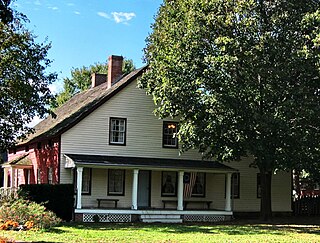
Glen Oaks is the easternmost neighborhood of the New York City borough of Queens. The neighborhood is part of Queens Community Board 13,< and borders Nassau County to the east.

Bellerose is a station along the Main Line and Hempstead Branch of the Long Island Rail Road, located in the Incorporated Villages of Bellerose and Floral Park, in Nassau County, New York. The station is at Commonwealth Boulevard and Superior Road, 0.25 miles (0.40 km) south of Jericho Turnpike.
Central Railroad of Long Island was built on Long Island, New York, by Alexander Turney Stewart, who was also the founder of Garden City. The railroad was established in 1871, then merged with the Flushing and North Side Railroad in 1874 to form the Flushing, North Shore and Central Railroad. It was finally acquired by the Long Island Rail Road in 1876 and divided into separate branches. Despite its short existence, the CRRLI had a major impact on railroading and development on Long Island.
Floral Park-Bellerose Union Free School District, also known as Floral Park-Bellerose School District 22, is a school district headquartered in Floral Park, New York, in the New York City metropolitan area. Its boundary includes Floral Park, Bellerose, Bellerose Terrace, and a small portion of North New Hyde Park. The district includes sections of the following towns: Hempstead and North Hempstead.
